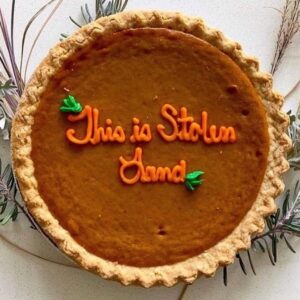Thanksgiving, the traditional story goes, began in 1621 when the Pilgrims celebrated their harvest by feasting with their Native neighbors, who had taught them how to fish, hunt, plant and otherwise survive in the New World.
The problem with the traditional story of Thanksgiving is its false premise: peaceful friendship between Indigenous Americans and those invading their homelands. The truth about the Pilgrims’ arrival in Massachusetts is that it resulted in centuries of escalating violence and dispossession for Indigenous people.
Here are some facts about Thanksgiving that many Americans are unaware of:
Thanksgiving more likely began in 1637 when Massachusetts Bay Governor William Bradford designated “a day of thanksgiving kept in all the churches for our victories against the Pequots.” The holiday was meant to celebrate the victory of colonial forces over the Pequot tribe in Mystic, Connecticut. In one raid, soldiers massacred over 700 Pequot men, women and children. Survivors were sold into slavery.
Bradford declared an official day of Thanksgiving to celebrate the annihilation of the Pequots. The celebration, which included a feast, became a custom observed every year. This is one possible origin of our current holiday.
Given this history of Thanksgiving, it is understandable that many Native Americans celebrate an alternative holiday on the fourth Thursday of November: the National Day of Mourning.
National Day of Mourning began in 1970 when Frank James, a Wampanoag activist, was asked to speak at an event observing the 350th anniversary of the Mayflower landing. But his invitation was retracted after his bluntly honest speech stunned the event planners.
James wrote: “It is with mixed emotion that I stand here to share my thoughts. This is a time of celebration for you—celebrating an anniversary of a beginning for the white man in America. A time of looking back, of reflection. It is with a heavy heart that I look back upon what happened to my People…Even before the Pilgrims landed it was common practice for explorers to capture Indians, take them to Europe and sell them as slaves for 220 shillings apiece. The Pilgrims had hardly explored the shores of Cape Cod for four days before they had robbed the graves of my ancestors and stolen their corn and beans.”
The event planners dis-invited James, calling his speech “inflammatory.” So James created a “National Day of Mourning” as an Indigenous response to Thanksgiving. Native people from throughout the Americas came to Plymouth, Massachusetts, where they mourned their ancestors who were sold into slavery, massacred, displaced, and exploited after English invasion.
Every year since 1970, Indigenous People have gathered in Plymouth, Massachusetts, where they honor their ancestors and advocate for surviving Native American communities, who continue to face oppression and mistreatment. National Day of Mourning brings attention to American history that is often obscured. As James shared in 1970, “What has happened cannot be changed, but today we must work towards a more humane America, a more Indian America, where men and nature once again are important; where the Indian values of honor, truth, and brotherhood prevail.”
Further Reading




